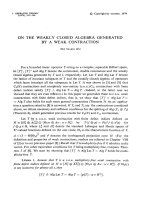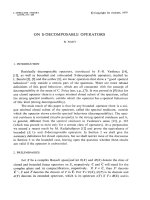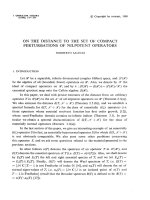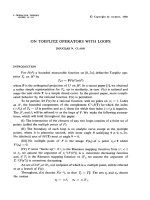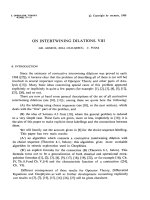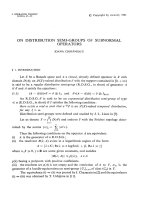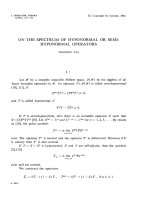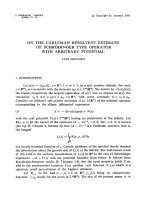Báo cáo toán học: "On counting permutations by pairs of congruence classes of major index" doc
Bạn đang xem bản rút gọn của tài liệu. Xem và tải ngay bản đầy đủ của tài liệu tại đây (115.17 KB, 10 trang )
On counting permutations by pairs of congruence
classes of major index
H
´
el
`
ene Barcelo and Robert Maule Sheila Sundaram
Department of Mathematics 240 Franklin St. Ext.
Arizona State University, Tempe, AZ Danbury, CT 06811
,
Submitted August 16, 2001; Accepted March 19, 2002.
MR Subject Classification: Primary 05E25
Abstract
For a fixed positive integer n, let S
n
denote the symmetric group of n! permuta-
tions on n symbols, and let maj(σ) denote the major index of a permutation σ. Fix
positive integers k<≤ n, and nonnegative integers i, j. Let m
n
(i\k; j\)denote
the cardinality of the set {σ ∈ S
n
:maj(σ) ≡ i (mod k), maj(σ
−1
) ≡ j (mod )}.
In this paper we use combinatorial methods to investigate these numbers. Results
of Gordon and Roselle imply that when k, are relatively prime,
m
n
(i\k; j\)=
n!
k ·
.
We give a combinatorial proof of this in the case when divides n−1andk divides n.
1 Introduction
Denote by S
n
the symmetric group of all n! permutations on the n symbols 1, ,n.First
recall some combinatorial definitions pertaining to permutations. See, e.g., [St].
Definition 1.1 Let σ ∈ S
n
. For 1 ≤ i ≤ n − 1,iis said to be a descent of σ if
σ(i) >σ(i +1).
Definition 1.2 The major index of σ, denoted maj(σ), is the sum of the descents of
σ.
The values of the statistic maj range from 0 (for the identity) to
n
2
.
In [BS], the following result was discovered using certain representations of the sym-
metric group S
n
, and then proved by means of a bijection as well.
Proposition 1.3 ([BS], Theorem 2.6) Fix an integer 0 ≤ i ≤ n − 1. Then
(n − 1)! = |{σ ∈ S
n
:maj(σ) ≡ i (mod n)}|.
This paper is similarly motivated by the following algebraic discovery. By considering
characters of the symmetric group that are induced from irreducible characters of the
cyclic subgroup of order n, and computing intertwining numbers, the following identity
was discovered, for fixed nonnegative integers i and j ([Su]).
(n − 2)! = |{σ ∈ S
n
:maj(σ) ≡ i (mod n), maj(σ
−1
) ≡ j (mod n − 1)}|, (A)
the electronic journal of combinatorics 9 (2002), #R21 1
Let m
n
(i\k; j\l) be the number of permutations σ in the symmetric group S
n
such that
maj(σ) ≡ i (mod k)andmaj(σ
−1
) ≡ j (mod l). In this paper we give a combinatorial
proof that if l divides n − 1andk divides n then m
n
(i\k; j\l)=n!/(kl). We also give a
completely bijective proof of the special case (A) of the main result.
We are very grateful to the first referee for providing the following information. It
turns out that our main result is an easy consequence of some results of Basil Gordon
[Go]. In fact, Gordon’s work implies a more general result: if k and l are relatively
prime and at most n then m
n
(i\k; j\l)=n!/(kl). Gordon gives a formula determining
a certain generating function, whose identification with the major index statistic is not
made clear in his paper, but is made explicit in yet another paper [R]. Gordon evaluates
his generating function at roots of unity, from which the result of this paper is easily
derived by algebraic manipulation, as well as the more general result stated above. For
the sake of completeness, we will present this proof in the next section. The methods of
the present paper, however, are purely combinatorial.
As pointed out by the second referee, the numbers m
n
(i\k; j\l)alsocountthenumber
of permutations in S
n
whose major index is congruent to i modulo k, and whose inversion
number is congruent to j modulo . This follows from a result of Foata and Sch¨utzenberger
[FS] which states that major index and inversion number are equidistributed on descent
sets. However in this paper our investigations focus exclusively on the major index.
The paper is organised as follows. In Section 2 the main technical lemmas are pre-
sented. In Section 3 we derive the main enumerative formulas of the paper, and in Section
4 we give some bijective proofs, including a bijective proof of the identity (A) above.
2 Preliminaries
This section contains the main lemmas that are needed for the rest of the paper.
Let γ ∈ S
n
be the n-cycle which takes i to i + 1 modulo n, for all i. We will sometimes
write γ
n
for clarity. The circular class of σ is the set of permutations [σ]={σγ
i
, 0 ≤ i ≤
n − 1}. The following observation is due to Klaychko [K]. For our purposes it is more
convenient to state the result in terms of the inverse permutation. This formulation also
admits an easy proof, which we give below for the sake of completeness.
Lemma 2.1 ([K], [Ga], Lemma 4.1) Let σ ∈ S
n
. Then the function τ → maj(τ
−1
)
takes on all n possible values modulo n in the circular class of σ. More precisely, we have
that maj(σγ
i
)
−1
≡ maj(σ
−1
)+i (mod n), 0 ≤ i ≤ n − 1.
Proof. Let τ = a
1
a
n
(written as a word). Then τγ = a
2
a
n
a
1
. Note that i is a
descent of τ
−1
if and only if i appears to the right of i +1 whenτ is written as a word in
{1, 2, ,n}.
By looking at occurrences of i to the right of i +1, it is easy to see that maj(τγ)
−1
−
maj(τ
−1
)=a
1
− (a
1
− 1) = +1, if a
1
=1,a
1
= n. If a
1
=1, then clearly maj(τγ)
−1
−
maj(τ
−1
)=+1, while if a
1
= n, then the difference is −(n − 1).
Hence in all cases the difference is +1 modulo n.
The basic idea of the next lemma is also to be found in [Gu]. We are again grateful
to the first referee for bringing this reference to our attention.
the electronic journal of combinatorics 9 (2002), #R21 2
Lemma 2.2 Let σ ∈ S
n−1
, and let σ
i
denote the permutation in S
n
obtained by
inserting n in position i of σ, 1 ≤ i ≤ n. Then for each k between 1 and n, th e values of the
major index on the set {σ
1
, ,σ
k
} form a consecutive segment of integers [m +1,m+ k],
and the value of maj(σ
k+1
) is either m or m + k +1 according as k is a descent of σ or
not, respectively. Note that maj(σ
n
)=maj(σ).
In particular, on the set {σ
1
, ,σ
n
}, the function maj takes on each of the n values
in the interval [maj(σ), maj(σ)+n − 1].
Proof. Let σ
= a
1
a
n−1
, with descents in positions i
1
, i
d
. Let σ be the permuta-
tion in S
n
obtained by appending n to σ
. Hence maj(σ)=maj(σ
). We shall show that
the value of maj(σ
) increases successively by 1 as n is inserted into σ
in the following
order:
1. first in the positions immediately following a descent, starting with the right-most
descent and moving to the left;
2. then in the remaining positions, beginning with position 1, from left to right.
For instance, if σ
= 14253, then the resulting permutations, beginning with σ and
then in the order specified above, are
142536, 142563, 146253, 614253, 164253, 142653,
with respective major indices 6,7,8,9,10,11.
Let σ
k
denote the permutation in S
n
obtained from σ
by inserting n in position k.
Thus σ
k
= a
1
a
k−1
na
k
a
k+1
a
n−1
for k =2, ,n− 1, and σ
1
= na
1
a
n−1
,
σ
n
= a
1
, a
n−1
n. Let ∆
k
denote the difference maj(σ
k
) − maj(σ
).
The following facts are easily verified:
1. If n is inserted immediately after a descent of σ
, i.e., if k = i
j
+1, 1 ≤ j ≤ d,
then n contributes a descent in position i
j
+1, but the i
j
th element ceases to be a
descent. Also the (d − j) descents to the right of n are shifted further to the right
by one. Thus
∆
k
=(d − j)+(i
j
+1)− i
j
= d − j +1,
and hence the difference ∆
k
ranges from 1 through d.
2. If 1 ≤ k ≤ i
1
, then the d descents to the right are shifted over by 1, and thus
∆
k
= d + k,
and hence ∆
k
ranges from d + 1 through d + i
1
.
3. If n is inserted in position k between two descents, but not immediately following a
descent, i.e., if 1 + i
j
<k≤ i
j+1
,j≤ d − 1, then
∆
k
=(d − j)+k,
and hence ∆
k
ranges from (d − j +2)+i
j
through d − j + i
j+1
.
the electronic journal of combinatorics 9 (2002), #R21 3
4. Finally when i
d
+2≤ k ≤ n − 1,
∆
k
= k,
and hence ∆
k
ranges from i
d
+ 2 through n − 1.
This establishes the claim. It also shows that as n is inserted into σ
from left to
right, the difference in major index goes up (from maj(σ
)) first by (d +1), then up by
one at each step, except when it is inserted immediately after the jth descent, in which
case it goes down to (d − j +1). Since when n is in position n, maj(σ
) is unchanged, this
establishes the statement of the lemma.
Remark 2.3 Note that in Lemma 2.2, it need not be true that the values of maj on
an arbitrary set {σ
j
, ,σ
j+r
},j>1, form a consecutive set of integers.
Lemma 2.4 Let σ ∈ S
n−1
, and let σ
i
denote the permutation in S
n
obtained by
inserting n in position i of σ, for 1 ≤ i ≤ n. Then maj(σ
−1
i
) ≡ maj(σ
−1
)(modn − 1).
Proof. Consider the effect of inserting n on the set of descents of σ
−1
. If n is inserted
to the right of n − 1, there is no change; if n is inserted to the left of n − 1, then n − 1
becomes a descent of σ
−1
i
. In either case, the major index of the inverse permutation is
unchanged modulo n − 1.
Finally we shall need the following result, which generalises Proposition 1.3. It is per-
haps known, although we do not know of a precise reference. There is an easy generating
function proof which we include for the sake of completeness. In Section 4 we will give a
constructive proof of the equivalent statement for inverse permutations.
Proposition 2.5 Let 1 ≤ k ≤ n. Then
n!
k
= |{σ ∈ S
n
:maj(σ) ≡ j (mod k)}|.
Proof. Recall the well-known formula due to MacMahon (see [St], p. 216, Corollary
4.5.9)
σ∈S
n
q
maj(σ)
=
n−1
i=1
(1 + q + + q
i
)(B)
Note that Lemma 2.2 gives an immediate inductive proof of formula (B).
Now fix integers 1 ≤ k ≤ n and 0 ≤ j ≤ k − 1. To show that the number of
permutations in S
n
with major index congruent to j (mod k)isn!/k, it suffices to show
that, modulo the polynomial (1 − q
k
), the left-hand side of (B) equals (n!/k) · (1 + q +
q
k−1
).
Since 1 + q + + q
i
=(1− q
i+1
)/(1 − q), it follows from the generating function that
for fixed k ≤ n, the sum on the left-hand side vanishes at all kth roots of unity not equal
to 1. Hence, modulo (1 − q
k
), there is a constant c such that
σ∈S
n
q
maj(σ)
= c(1 + q + + q
k−1
).
the electronic journal of combinatorics 9 (2002), #R21 4
Putting q =1yieldsc = n!/k, as required.
We end this section with the result pointed out by the first referee, mentioned in the
introduction, which is proved along the same lines as Proposition 2.5 by using crucial
results of Gordon [Go] and Roselle[R].
Theorem 2.6 Let k, ≤ n, and assume k, , are relatively prime. Then
m
n
(i\k; j\)=
n!
k
.
Proof. Let H
n
(q
1
,q
2
)=
σ∈S
n
q
maj(σ)
1
q
maj(σ
−1
)
2
. Let ω
k
denote a primitive kth root of
unity. It follows from results of Gordon [Go] and Roselle [R] that if 1 <g= h ≤ n, then
H
n
(ω
g
,ω
h
)=0.
Now apply this result with g = k, h = . Let
R
n
(q
1
,q
2
)=
0≤i≤k−1,0≤j≤−1
m
n
(i\k; j\)q
i
1
q
j
2
.
By the result mentioned above, this vanishes for q
1
= ω
k
,q
2
= ω
. But ω
i
k
ω
j
= ω
i+jk
k
. It
is easy to verify that because k and are relatively prime, the exponent i + jk runs over
all k distinct residue classes modulo k, for 0 ≤ i ≤ k − 1and0≤ ≤ j − 1. Hence
R
n
(ω
k
,ω
) is a linear combination of all k roots of unity which vanishes. This implies
that the polynomial
P
n
(q)=
0≤i≤k−1,0≤j≤−1
m
n
(i\k; j\)q
α(i,j)
,
where α(i, j) is some fixed permutation of the k integers {0, ,k− 1}, vanishes at a
primitive k-th root of unity. Hence there is a constant c such that
P
n
(q)=c(1 + q + + q
k−1
).
It follows immediately that m
n
(i\k; j\)=c. Putting q =1givesc =
n!
k
.
3 Enumerative Results
Recall that m
n
(i\k; j\) denotes the number of permutations σ ∈ S
n
with maj(σ) ≡ i
(mod k)andmaj(σ
−1
) ≡ j (mod ). We give a combinatorial proof of:
Theorem 3.1 Let be a divisor of n − 1,=1, and let k be a divisor of n, k =1.
Fix 0 ≤ i ≤ k − 1, 0 ≤ j ≤ − 1. Then
m
n
(i\k; j\)=
n!
k ·
.
the electronic journal of combinatorics 9 (2002), #R21 5
Proof. Let σ ∈ S
n−1
, and construct σ
i
,i=1, ,nin S
n
as in Lemma 2.2, by inserting
n in position i. Since |n − 1, we have by Lemma 2.4 that for all i,
maj(σ
−1
) ≡ maj(σ
−1
i
)(mod).
By Lemma 2.2, since the set {maj(σ
i
):i =1, ,n} consists of n consecutive integers,
each congruence class modulo k appears exactly
n
k
times.Hencewehave
m
n
(i\k; j\)=
n
k
·|{σ ∈ S
n−1
:maj(σ
−1
) ≡ j (mod )}|
and the result now follows from Proposition 2.5.
By examining Lemma 2.2 more closely, we obtain the following recurrence on n for
these numbers in the case when k and are divisors of n − 1.
Proposition 3.2 Let , k be divisors of n − 1,=1,k=1. Then
m
n
(i\k; j\)=(n − 2)!
(n − 1)
2
k ·
+ m
n−1
(i\k; j\).
Proof. Let σ ∈ S
n−1
, and construct σ
i
,i=1, ,nin S
n
as in Lemma 2.2, by inserting
n in position i. Since |n − 1, we have by Lemma 2.4 that for all i,
maj(σ
−1
) ≡ maj(σ
−1
i
)(mod).
Now let k|n − 1. By Lemma 2.2, the major indices of the first n − 1elementsσ
i
,
i =1, ,n− 1, form a segment of n − 1 consecutive integers, and hence the residue class
i modulo k appears exactly
n−1
k
times among them. Also note that maj(σ)=maj(σ
n
).
Hencewehave
m
n
(i\k; j\)=
n − 1
k
|{σ ∈ S
n−1
:maj(σ
−1
) ≡ j (mod )}|
+|{σ ∈ S
n−1
:maj(σ
−1
) ≡ j (mod ), maj(σ) ≡ i (mod k)}|.
Collecting terms and using Proposition 2.5, we obtain
m
n
(i\k; j\)=
n − 1
k
(n − 1)!
+ m
n−1
(i\k; j\),
as required.
We note that while the above arguments are not symmetric in k and , the numbers
m
n
(i\k; j\) satisfy
m
n
(i\k; j\)=m
n
(j\; i\k). (C)
This follows by applying the involution τ → τ
−1
.
For arbitrary choices of k, , these numbers usually depend on the values of i and j.
For example for n =4, we have m
4
(0\2; 0\2) = 8 = m
4
(1\2; 1\2), and m
4
(1\2; 0\2) =
4=m
4
(0\2; 1\2). When k = =3, we have m
4
(0\3; 0\3) = 4,m
4
(0\3; 1\3) = 2 =
m
4
(0\3; 2\3); and m
4
(1\3; 1\3) = 3 = m
4
(1\3; 2\3). The other values follow by symmetry
from (C).
Note that in view of Proposition 2.5, we know that, for fixed , the sum over i =
0, 1, ,k− 1ofthenumbersm
n
(i\k; j\)is
n!
.
the electronic journal of combinatorics 9 (2002), #R21 6
4 Some bijections
In this section we present bijective proofs for some of the results derived in Sections 3
and 2. Recall that this paper was originally motivated by the algebraic discovery of the
formula (A). We now give a bijective proof of (A), which is the special case k = n, = n−1
of Theorem 3.1, namely
m
n
(i\n; j\n − 1) = (n − 2)!
Proposition 4.1 (Bijection for the case k = n, = n − 1 of Theorem 3.1.) Fix
integers 0 ≤ i ≤ n − 1, 0 ≤ j ≤ n − 2. Then the number of permutations σ in S
n
such that
maj(σ) ≡ i (mod n) and maj(σ
−1
) ≡ j (mod n − 1), equals (n − 2)!
Proof. First note that (n − 2)! counts the number of permutations in S
n−1
having
n − 1 as a fixed point. Let A
n−1
be this set of permutations, and let B
n
be the subset of
S
n
with major indices as prescribed in the statement of the theorem. Given σ ∈ A
n−1
, by
Lemma 2.1 there is a unique circular rearrangement σ
in S
n−1
whose inverse has major
index congruent to j (mod n−1). Lemma 2.2 then shows that, for each i =0, 1, ,n−1,
there is a unique position in σ
in which to insert n, in order to obtain a permutation
σ
∈ S
n
such that maj(σ
) ≡ i (mod n). By Lemma 2.4, the passage from σ
to σ
does not
change the major index of the inverses modulo n−1, and thus maj(σ
−1
)=maj(σ
−1
) ≡ j
(mod n − 1). Hence σ → σ
gives a well-defined map from A
n−1
to B
n
. To see that this
is a bijection, given σ
∈ B
n
, erase the n to obtain σ
∈ S
n−1
, and let σ be the unique
circular rearrangement of σ
such that σ(n − 1) = n − 1. Then σ ∈ A
n−1
, and clearly the
map is a bijection.
Example 4.1.1 Let n =6,i=2,j =3. Take σ = 21345 ∈ A
5
. Note that maj(σ
−1
)=
1. The unique circular rearrangement whose inverse has major index equal to 3(≡ 3
(mod 5)) is σ
= 34521. Now maj(σ
)=7, since the descents are in positions 3 and
4. Now use the proof of Lemma 2.2. To obtain a permutation with major index 8 (≡ 2
(mod 6)), insert 6 into position 5, immediately after the right-most descent. This gives
σ
= 345261 ∈ B
6
.
The remainder of this section is devoted to giving a constructive proof of Proposition
2.5. A bijection for the case k = n was given in [BS], using Lemma 2.1. We do not know
of a bijection for arbitrary k, but a bijection for the case k = n − 1 is given in the proof
which follows.
Proposition 4.2 (Bijection for the case k = n − 1 of Proposition 2.5.) Fix an integer
0 ≤ j ≤ n − 2. The number of permutations in S
n
with major index congruent to j
(mod n − 1) is n(n − 2)! = n!/(n − 1).
Proof. Let B
n
denote the set {σ ∈ S
n
:maj(σ
−1
) ≡ j (mod n − 1)}. It suffices to
show that this set has cardinality n(n − 2)!. Let C
n
denote the set of permutations τ ∈ S
n
such that, when n is erased, n − 1 is a fixed point of the resulting permutation τ
in S
n−1
.
Observe that C
n
has cardinality n(n−2)!, since the number of permutations in S
n−1
which
fix n − 1is(n − 2)!, and there are n positions in which n can be inserted.
We describe a bijection between C
n
and B
n
. If τ ∈ C
n
, let τ
be the permutation
in S
n−1
obtained by erasing n. By definition of C
n
,τ
(n − 1) = n − 1. By Lemma 2.1,
the electronic journal of combinatorics 9 (2002), #R21 7
there is a unique circular rearrangement τ
∈ S
n−1
of τ
such that the major index of
the inverse of τ
is congruent to j (mod n − 1). Now construct ˜τ ∈ S
n
by inserting n
into τ
in the same position that it occupied in τ, i.e., ˜τ
−1
(n)=τ
−1
(n). By Lemma 2.4,
maj(˜τ
−1
)=maj(τ
−1
) ≡ j (mod n − 1). Hencewehaveamapτ → ˜τ ∈ B
n
. It is easy to
see that this construction can be reversed exactly as in the proof of Proposition 4.1, and
hence we have the desired bijection.
Example 4.2.1 Let n =5,j =2. Take τ = 32154. Then τ belongs to the set C
5
of
the preceding proof. Erasing 5 yields τ
= 3214, whose inverse major index is 3. The
third cyclic rearrangement τ
= 4321 then has inverse major index 6 ≡ 2(mod4), and
τ → ˜τ = 43251.
Now we examine Klyachko’s Lemma 2.1 more closely. We obtain the following result,
which specialises, in the case k = n, to Proposition 1.3.
Lemma 4.3 Fix integers 1 ≤ k ≤ n, 0 ≤ j ≤ k − 1 and 1 ≤ a ≤ n − k +1.
1. Then
(n − 1)! = |{ σ ∈ S
n
:maj(σ
−1
) ≡ j (mod k),σ
−1
(n) ∈ [n − a − k +2,n− a +1]}|.
2. Let n = qk + r, 0 ≤ r ≤ k − 1. Fix an integer s between 1 and q. Then
s(n − 1)! = |{σ ∈ S
n
:maj(σ
−1
) ≡ j (mod k),σ
−1
(n) ∈ [n − sk +1,n]}|.
Proof. Let A
n
denote the set of permutations in S
n
which fix n, and let B
n
denote the
subset of S
n
subject to the conditions in the statement of part (1). Let τ ∈ A
n
. Consider
the circular class of τ consisting of the set {τ,τγ, ,τγ
n−1
}. The proof of Lemma 2.1
shows that because τ(n)=n, we have the exact equality maj(τγ
i
)=maj(τ)+i, for
0 ≤ i ≤ n − 1. In particular, for any 1 ≤ k ≤ n, the first k circular rearrangements
τγ
i
, 0 ≤ i ≤ k − 1, have the property that the major indices of their inverses form
a complete residue system modulo k. More generally, this observation holds for any k
consecutive circular rearrangements τγ
i
,a ≤ i ≤ a + k − 1, where a is any fixed integer
1 ≤ a ≤ n − k +1.
Hence for every τ ∈ A
n
, there is a unique i, a ≤ i ≤ a + k − 1suchσ = τγ
i
has
maj(σ
−1
) ≡ j (mod k). Since n is in position n − i in τγ
i
, clearly n − a − k +2 ≤
σ
−1
(n) ≤ n − a +1. Thus τ → σ gives a well-defined map from A
n
to B
n
. Conversely
given σ ∈ B
n
, with σ
−1
(n)=n − i +1,a≤ i ≤ a + k − 1, let τ ∈ S
n
be defined by
τγ
i
= σ. Then clearly τ (n)=n, and τ ∈ A
n
. This shows that our map is a bijection, and
(1) is proved.
For (2), again we start with the set A
n
of the (n − 1)! permutations in S
n
which
fix n. Let τ ∈ A
n
. Then as in the preceding proof, for i =0, 1, ,sk− 1, the first sk
circular rearrangements τγ
i
have n in position (n − i), and maj((τγ
i
)
−1
)=maj(τ)+i.
In particular, for each J =1, ,s, the major index of the inverse permutations in the
subset {τγ
(J−1)k+i
:0≤ i ≤ k − 1} is a complete residue system modulo k. Hence the first
sk rearrangements contain exactly s permutations with inverse major index congruent to
j (mod k). This establishes (2).
the electronic journal of combinatorics 9 (2002), #R21 8
We are now ready to give a constructive proof of an equivalent restatement of Propo-
sition 2.5, by looking at the circular classes of permutations τ ∈ S
n
which fix n. Note
that the statement of Proposition 4.4 ( or Proposition 2.5) is invariant with respect to
taking inverses, i.e., it says that
n!
k
is also the number of permutations in S
n
with con-
stant major index modulo k. Our constructive proof, however, works only for the inverse
permutations.
Proposition 4.4 (Constructive proof)
n!
k
= |{σ ∈ S
n
:maj(σ
−1
) ≡ j (mod k)}|.
Proof. We proceed inductively. We assume k ≤ n − 1, since the case k = n was
dealt with in Proposition 1.3. It is easy to verify directly that the statement holds for
n =3. Assume we have constructed the permutations in S
n−1
with inverse major index
congruent to j (mod k). Note that this means we can identify these permutations in the
subset A
n
of S
n
. Let τ ∈ A
n
. We show how to pick out the permutations in the circular
class of τ with inverse major index congruent to j (mod k). Let n = qk + r. Taking
s = q in Lemma 4.3 (2), the proof shows how to pick out the q permutations in the first
qk circular rearrangements τγ
i
, 0 ≤ i ≤ qk − 1. Now consider the remaining r (recall
r<k) rearrangements τγ
i
,qk ≤ i ≤ qk + r − 1. These will contain a (necessarily unique)
permutation with inverse major index congruent to j (mod k), iff maj(τ
−1
) ≡ j − i
(mod k), for qk ≤ i ≤ qk + r − 1, i.e., iff maj(τ
−1
) ≡ j − t (mod k), for t =0, ,r− 1.
By induction hypothesis for each t =0, ,r − 1, there are exactly (n − 1)!/k such
permutations in A
n
. Hence there are r(n − 1)!/k permutations in A
n
whose circular class
is such that, among the last r rearrangements, there is a permutation with inverse maj
congruent to j (mod k).
We have thus accounted for exactly q(n−1)!+r(n−1)!/k = n!/k permutations σ ∈ S
n
with maj(σ
−1
) ≡ j (mod k).
References
[BS] H. Barcelo and S. Sundaram, On some submodules of the action of the symmetric
group on the free Lie algebra, J. Alg. 154, No. 1 (1993), 12–26.
[FS] D. Foata and M P. Sch¨utzenberger, Major index and inversion number of permuta-
tions, Math. Nach. 83 (1978), 143–159.
[Ga] A. M. Garsia, Combinatorics of the free Lie algebra and the symmetric group,
in Analysis Et Cetera: Research papers published in honor of J¨urgen Moser’s 60th
birthday, Paul H. Rabinowitz and Eduard Zehnder, eds., Academic Press, San Diego,
CA (1990).
[Go] B. Gordon, Two theorems on multipartite partitions, J. London Math. Soc. 38
(1963), 459–464.
the electronic journal of combinatorics 9 (2002), #R21 9
[Gu] H. Gupta, A new look at the permutations of the first n natural numbers, Indian J.
Pure Appl. Math. 9 (1978), 600–631.
[K] A. A. Klaychko, Lie elements in the tensor algebra, Siberian Math. J. 15,No.6
(1974), 1296–1304.
[R] D. P. Roselle, Coefficients associated with the expansion of certain products, Proc.
Amer. Math. Soc. 45 (1974), 144–150.
[St] R. P. Stanley, Enumerative Combinatorics, Vol. 1, Wadsworth & Brooks Cole, Mon-
terey, CA (1986).
[Su] S. Sundaram, unpublished.
the electronic journal of combinatorics 9 (2002), #R21 10
